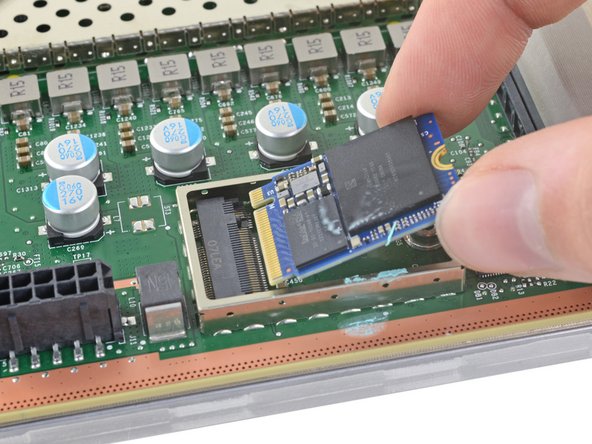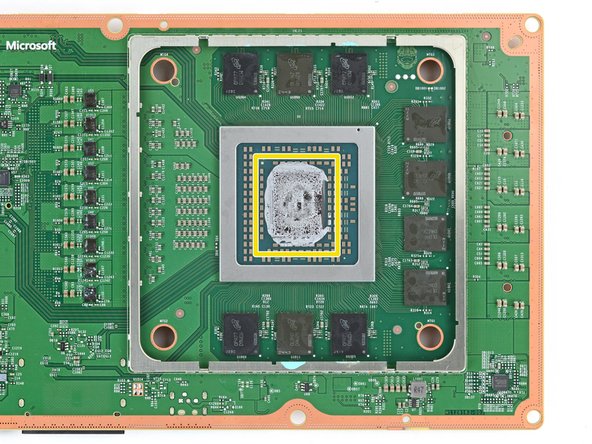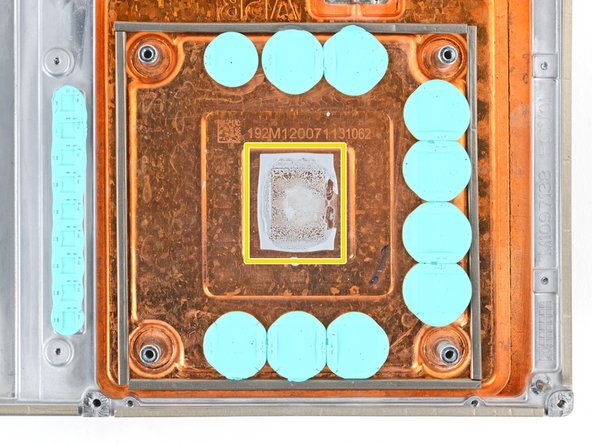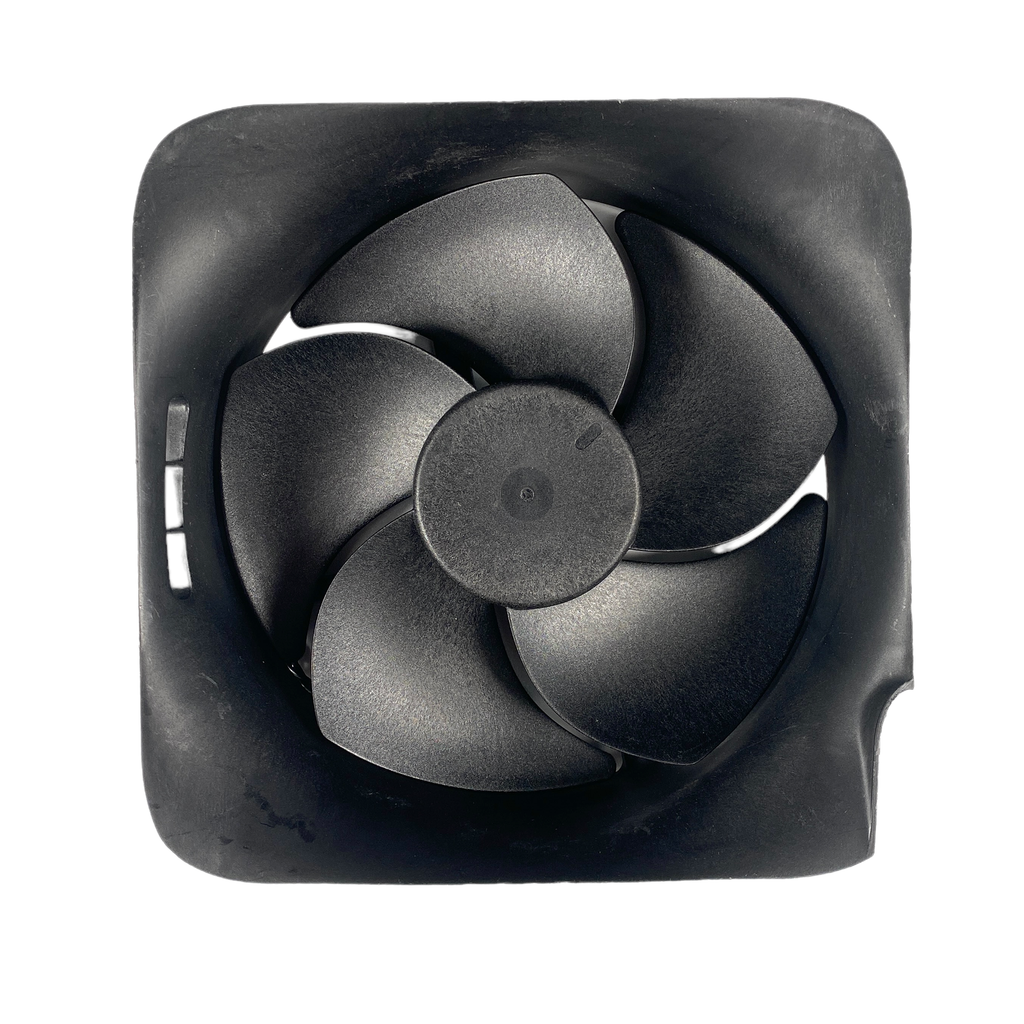DIY Guide: How to Replace Xbox Series X Galaxy Motherboard
Duration: 45 minutes
Steps: 52 Steps
Go ahead and power down your device and unplug all the cords like a pro!
Let’s get this Xbox Series X motherboard swap done! This guide also covers how to refresh that thermal paste. Before we start, make sure your console is completely powered down and unplugged – safety first! And while we’re at it, remember those ESD rules – we don’t want to zap anything! Let’s get started.
Step 1
Before you dive in, make sure to power down your console completely and disconnect all those pesky cables. You’re on the path to a fix, and we want you to stay safe while doing it!
– Grab your trusty tweezers and gently peel off the sticker that’s playing hide and seek with the first screw on the back panel, right by the base. Let’s get to work!
Tools Used
Step 2
To make removal a breeze, warm up that sticker with an iOpener or a handy hair dryer.
Just peel back the sticker enough to uncover the sneaky hidden screw—no need to go overboard and rip it off completely.
Sure, these are tamper-evident stickers, but don’t sweat it—Microsoft can’t void your warranty as long as you keep everything intact. Enjoy the process!
– Grab a pair of blunt tweezers and gently lift that big sticker off the back panel to uncover the hidden second screw. You’ve got this!
Tools Used
Step 3
As you dive into this repair adventure, keep a close eye on every screw! Make sure each one finds its way back home to avoid any mishaps with your console.
– Grab your trusty T8 Torx driver and let’s get to work! Carefully unscrew the two screws that are holding the back panel in place; they’re 7.4 mm long and ready to be removed. You’ve got this!
Step 6
– Take hold of that back panel where you made the opening and gently tug it up and away from the shell to release those long edges. You’ve got this!
– When it’s time to put everything back together, just press along the edges of the back panel to snap it snugly into place. You’re almost there!
Step 7
Pop the back panel into the cozy little nook at the top of the shell. It’s like giving it a warm hug!
– Gently lift the back panel and slide it away from the top edge of the shell to free it from the gap.
– Now, go ahead and remove that back panel completely.
Step 8
– Grab your trusty T8 Torx driver and let’s get those three screws out that are holding the fan snugly to the center chassis:
– One charming 10.5 mm pancake screw
– Two delightful 8.8 mm screws
Step 9
Hey, let’s be careful with those cables, alright? Always grab the connector, not the wires themselves. You wouldn’t want to cause any unexpected disconnections, would you?
– Grab the fan cable connector with your fingers or a pair of blunt tweezers, and gently pull it up to disconnect it from the chassis. No need to be rough, just a little tug will do the trick!
– When you put everything back together, make sure to route the fan cable underneath its little cable guide on the fan housing. This will keep it out of the way of the back panel, and you won’t have any trouble getting it all back together smoothly.
Tools Used
Step 10
– Gently slide the fan out of its snug little home to set it free.
– When you’re putting it back, remember it’s a one-way street—make sure Master Chief is looking right at you. You’ve got this!
Step 12
You might need to give that locking tab a little nudge to help get the base started.
Once it’s locked in place, you’ll know it’s right because the “Hello from Seattle” line will be nice and straight with the device’s sides.
– Grab that base and give it a twist to the left—counterclockwise, that is! This will set it free from the shell.
– Now, go ahead and lift out the base. You’ve got this!
– When it’s time to put things back together, just drop those base tabs into their cozy holes on the shell, then twist to the right until you hear that satisfying snap into the interior locking tab.
Step 13
– Grab your trusty T8 Torx driver and let’s get to work! You’ll want to remove those two 8.8 mm screws that are keeping the optical drive’s vibration isolator snugly attached to the shell. One screw is hanging out at the base, and the other is chilling on the top of the isolator. Let’s set them free!
Step 14
The vibration isolator hugs the sides of the optical drive with its silicone pads. To get it off, you might need to gently “walk” the isolator off each side of the drive. Take your time and be patient! If you need help, you can always schedule a repair.
– Time to give that optical drive a little lift! Gently nudge the vibration isolator upwards to free it.
– Now, when you’re putting things back together, make sure that vibration isolator is snuggled in nice and tight around both edges of the optical drive. You want it to sit flush with the rest of the center chassis, like a happy little camper.
Step 15
Always grab those cables by their connectors, not the wires! Keep it cool and avoid any wire mishaps.
– Grab a pair of blunt tweezers and gently squeeze the edges of the optical drive power connector. Give it a little tug upwards to disconnect it from the optical drive.
– Now, using your fingers, carefully pull up to disconnect the data cable from the optical drive. You’ve got this!
Tools Used
Step 16
If the drive isn’t lined up just right, you won’t be able to pop in that top vibration isolator like a champ, and your disc reader may end up a bit out of whack with the front of the console. Let’s make sure everything is perfectly aligned so your repair goes smoothly!
– Grab the top edge of the optical drive and gently slide it out of its slot in the shell—easy does it!
– When putting it back together, line up the pegs on the bottom edge of the optical drive with the guide holes on the shell’s base. You’ve got this!
Step 17
Hey there! Those ribbon cables and their connectors are super delicate, so make sure to open those locking tabs with care and gently pull the cables. You’ve got this!
– Grab your spudger and use the flat end to pop open the metal locking tab on the USB port ribbon cable—easy does it!
– When putting it back together, slide the cable in and give the metal locking tab a gentle snap to secure it. You’ve got this!
Tools Used
Step 18
Gently tug on the pull tab—leave the cable alone, it’s just trying to chill.
If the USB port cable seems to be stuck to the metal chassis, give it a little warmth with an iOpener or a hair dryer. Depending on your Xbox model, you might also want to gently slide an opening pick underneath the cable to help break that adhesive bond.
– Grab a trusty pair of tweezers and gently tug on that black plastic pull tab to unplug the USB port cable. You’ve got this!
Tools Used
Step 19
Give that pull tab a gentle tug, but keep your hands off the cable itself!
Remember, before you yank on the cable, make sure to press down on the metal tab. Otherwise, you might end up giving the cable or connector a bad day!
– Grab your trusty spudger and gently press down on the metal tab next to the power button cable’s board connector. You’re doing great!
– With that tab pressed down, take a pair of tweezers and give that pull tab a little tug to disconnect the power button cable from the center chassis. Easy peasy!
– When you’re putting it all back together, just slide the cable in, and it should make a satisfying little ‘snap’ as it locks into place. You’ve got this!
Step 20
– Grab your trusty T8 Torx driver and get ready to tackle those three 7.4 mm screws that are holding the center chassis assembly snugly in place. Let’s loosen them up and set your device free!
Step 21
Depending on your Xbox model, the sticky stuff might be hiding on the underside of the cable. If that’s the case, grab an iOpener or a hair dryer to warm things up a bit!
– Carefully lift away the USB port ribbon cable that’s stuck to the heatsink, like peeling off a sticker. You’ve got this!
Tools Used
Step 22
The center chassis fits snugly against the shell with some handy guide pegs. To lift out the chassis, just give those pegs a little slide out of their cozy slots. You’ve got this!
– Grab hold of the middle section and pull it towards the green fan thingie at the top, gently detaching those little guide pegs. It’s like a puzzle, but without the frustration!
– Now, lift the whole middle section right out – you’ve got this! Don’t be afraid to give it a little wiggle if it’s feeling stubborn.
– When putting it all back together, keep an eye on those ribbon cables. You don’t want to pinch them, so take it slow and easy. It’s like threading a needle, but cooler.
Step 23
– Detach the chassis strap from the power supply’s right side. You’re almost there!
Step 24
– Gently lift the chassis strap up and away from the power supply like you’re unveiling a surprise.
– Once the strap is free, just set that loose end aside for now—it’s not going anywhere!
Step 25
– Grab your trusty T8 Torx driver and let’s get those screws out! First, you’ll want to tackle the three screws holding the power cable port snugly to the chassis.
– Make sure to remove two screws measuring 13.1 mm.
– And don’t forget the one special screw that’s 35 mm long. You’ve got this!
Step 26
– Gently pop the power connector out of its cozy little home in the chassis. You’ve got this!
Step 27
– Pop open the lid on the plastic guide of the power cable like a pro!
Step 28
– Gently pull the power cable out from beneath the extra section of the cable guide.
Step 29
– Grab your trusty T8 Torx driver and let’s get that 8.8 mm screw out of the way! It’s holding the power supply corner cover, and we need to free it up for the next step. You’re doing great!
Step 31
– Time to get your repair on! Use a T8 Torx driver to remove the three 9.6 mm screws that are holding the accessory antenna board in place on the center chassis. Easy peasy!
Step 32
– Grab that antenna board and give it a gentle tug straight out from the center chassis to disconnect it. You’ve got this!
– When it’s time to put everything back together, just line up the board’s connector with the port on the center chassis and give it a nice press to reconnect. Easy peasy!
Step 33
– Grab your trusty T8 Torx driver and let’s tackle those nine screws holding the board shield in place:
– Six sleek 8.8 mm black screws
– Two shiny 35 mm silver screws
– One special 13.1 mm silver screw
Step 34
– Let’s get that board shield out of the way! Gently lift it up, and it’ll come right off the center chassis.
Step 35
– Alright, time to give those chassis straps a little wiggle! Unclip them from the locking tabs on either side of the power supply. It’s like giving your device a gentle hug, but without the awkwardness. 😉
Step 36
– Time to ditch that chassis strap! Give it a gentle tug and watch it go.
Step 37
Always grab those cables by their connectors—leave the wires alone!
– Give that locking tab on the 10-pin power connector a nice little squeeze to get a grip.
– While you’ve got it compressed, gently lift the connector straight up to unplug it from the board.
Step 38
Once those locking tabs are properly pressed down, the interconnect cable should glide out effortlessly—no muscle required!
– Take hold of the base of the interconnect cable connector like a pro.
– Press down on each side of the connector to release those sneaky cable locking tabs.
– With the tabs out of the way, grab the edges of the interconnect cable and pull it out straight from the connector to disconnect it.
– When you’re putting it all back together, that interconnect cable should click right into place as you fully insert it.
Step 39
– Grab your T8 Torx driver and let’s tackle those three shiny silver screws, each measuring 35 mm long, from the power supply—just remember to leave the lone black screw hanging out!
Step 40
– Gently hold onto the sides of the central chassis (just avoid the power supply!) and carefully lift it away from the motherboard and heatsink assembly. Don’t forget to guide that interconnect cable through its little cutout as you go!
Step 41
The SSD shield comes with thermal pads on both sides, so let’s keep those little guys in one piece while we work our magic!
– Grab that trusty spudger and gently work the flat end under the edges of the metal SSD shield. Go ahead, it’s okay to pry a little!
– Once you’ve got it lifted, carefully take off the SSD shield and set it aside.
Tools Used
Step 42
– Grab your trusty T8 Torx driver and unscrew that 5.2 mm screw holding the SSD in place. You’ve got this!
Step 43
Once you’ve taken out the SSD screw, the SSD will gracefully lift up at a slight angle, just waiting for you to give it a little nudge.
– Grab the end of the SSD and give it a gentle tug to detach it from the M.2 board connector. Easy peasy!
– When putting it back together, slide the SSD in at a slight angle into its board connector, then flatten it out and secure it with the SSD screw. You’ve got this!
Step 44
If your interconnect cable has a locking tab in the middle, you can skip ahead to the next step – you’re a superstar!
With the locking tabs pressed down just right, that interconnect cable will slide out like a smooth operator. No need to muscle it!
– Start by giving a gentle grip to the base of the interconnect cable connector, just like you’re holding onto a precious snack!
– Press down on each side of the connector to release those stubborn cable locking tabs – it’s like unlocking a treasure chest!
– With the tabs relaxed, take hold of the interconnect cable’s edges and smoothly pull it out straight from the connector to free it up.
– Now, it’s time to say goodbye to the interconnect cable; remove it with care.
– When it’s time to put everything back together, just remember: the interconnect cable should ‘snap’ into place like a puzzle piece finding its home!
Step 45
– Give that interconnect cable connector a little pinch on the locking tab, then use the flat end of a spudger to pop the clip open. Easy peasy, right?
– Now, grab that connector and pull it straight up and out of its socket. You got this!
– Time to put things back together. Line up the #1—SOC side of the interconnect cable connector with its socket, making sure the locking tab is facing out. Then, gently press down on the edges of the connector until it clicks into place. You’re almost there!
Tools Used
Step 46
Keep it cool and steady—those components near the metal shield are delicate, so handle with care!
– Gently lift the edges of the large metal shield in the center of the motherboard using the flat end of a spudger. Easy does it!
Tools Used
Step 47
– Time to say goodbye to that metal shield! Gently remove it and set it aside.
– When you’re putting everything back together, don’t forget to place the shield back on. Give it a good press around the edges to make sure it’s snug and secure. You’ve got this!
Step 48
When you’re working on the APU tension bracket, take it easy! Loosen and tighten those screws just a little bit at a time, and use an ‘X’ pattern to keep things balanced. Think of it like this: start at the top left, then move to the bottom right, next to the top right, and finish up at the bottom left. You’ve got this!
– Grab your trusty T8 Torx driver and get ready to tackle those four APU tension bracket screws, each measuring 12.3 mm long. Let’s get this show on the road!
Step 49
Hey there! Just a friendly reminder: keep that APU bracket steady! Moving it side to side could give those delicate surface-mounted components a tough time. So, remember to lift it straight up with care!
– Gently lift the APU bracket straight up with your fingers and take it off. You’ve got this!
– When putting it back together, make sure the black plastic bits are aligned with the long edges of the motherboard. The plastic piece with the round hole (not the oblong one) should be nearer to the interconnect cable socket. Check out this photo for a handy reference!
Step 50
Depending on the condition of the thermal paste and putty, the board might be stuck to the heatsink assembly. If you find it’s a bit stubborn, grab a spudger and gently pry up the edges of the board to separate them.
– Gently lift the motherboard straight up and away from the heatsink to free it.
– When putting it back together, be sure to position the board on the heatsink with the APU side facing down. Keep in mind there’s some thermal paste hanging out on the bottom of the board, so make sure to use the alignment pegs for a perfect fit. If you need to adjust its position, just be cautious as it might smudge that thermal paste.
Tools Used
Step 51
Reusing the motherboard? Awesome! Just remember to give that APU a good clean too. And hey, to keep those tiny resistors safe and sound, grab some cotton swabs for the job!
– Get ready to dive into the fun world of tech! Dust off that heatsink and let’s give your APU some fresh thermal paste love. It’s easier than it sounds, and we’re here to guide you through it!
Tools Used
Step 52
Make sure to pay attention to where the thermal putty pieces are, including their shape and size. When you replace them, it’s essential that you use pieces that match perfectly!
– Ready to put your device back together? Just follow these steps in reverse and you’re set!
– Got some old tech lying around? Make sure to drop it off at an R2 or e-Stewards certified recycler.
– Things didn’t turn out quite as you expected? No worries! A little troubleshooting might do the trick, or feel free to reach out to our community for some support.
– Oops! If you’re stopping here, that’s totally fine. Just hit cancel.
–
Tools Used
Success!
































































































































